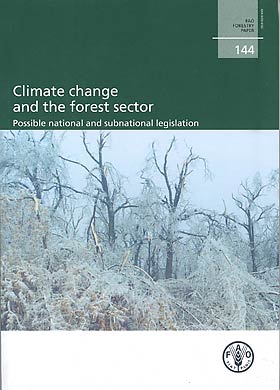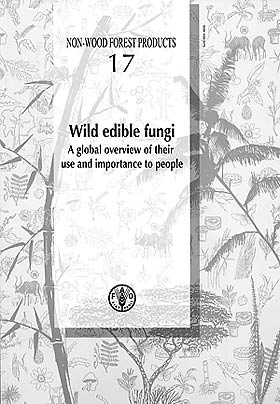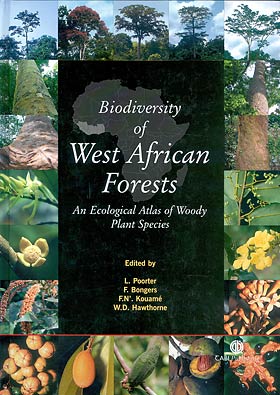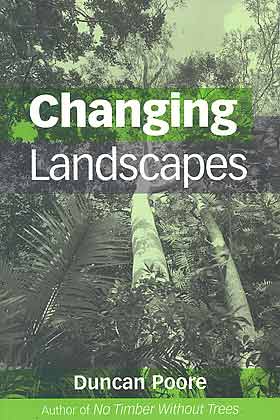

Climate change and the forest sector – possible national and subnational legislation. K.L. Rosenbaum, D. Schoene & A. Mekouar. 2004. FAO Forestry Paper No. 144. Rome, FAO. ISBN 92-5-105200-X.

Climate change presents the world with a daunting problem. Emerging science suggests that humans may be about to cause a major change in world climates. The economic and ecological stakes are high. Responding to the challenge will require pioneering efforts in science, politics, pollution control, forest management and law. In an ideal world, mature science would guide policy and legal reform. But in the real world, it is not always possible to have the certainty to make strictly rational decisions based on scientific insight.
Climate change and the forest sector – possible national and subnational legislation examines the development of international law related to climate change and discusses issues that national and subnational legislative bodies may have to consider regarding climate change mitigation and forests. It analyses the different conclusions the Parties to the United Nations Framework Convention on Climate Change (UNFCCC) have reached in national legislation to foster the role of forests in the international response to climate change. It notes that to date, national legislative activity on forests and climate change has been limited, with some exceptions (e.g. Australia, Costa Rica, the Dominican Republic).
This concise publication presents the legal and institutional issues of laws promoting forest-based mitigation of climate change, including afforestation, reforestation and forest management. It discusses the approach of a national command-and-control system and the application of subsidies to promote the use of forests as sinks, as well as the enhancement of forest carbon sequestration through information mechanisms (e.g. extension services, forest certification and research). The authors conclude that in finalizing most of the rules on Land Use, Land-Use Change and Forestry (LULUCF), the ninth Conference of the Parties clarified the role of forests in meeting sequestration goals, which should help those Parties that wish to adopt laws on LULUCF activities. Nations should now be tackling the question of whether and how to encourage and integrate the use of forests as carbon sinks in national legal regimes.
The publication is also available online: www.fao.org/docrep/007/y5647e/y5647e00.htm
Wild edible fungi – a global overview of their use and importance to people. E. Boa. 2004. Non-Wood Forest Products No. 17. Rome, FAO. ISBN 92-5-105157-7.

At the international level, much attention is focused on how forests and forest products can contribute to alleviating poverty and food insecurity. One way that FAO contributes to this goal is by promoting the development and sustainable use of non-wood forest products for income generation, food security and conservation of biodiversity.
Fungi, including mushrooms, are an important group of non-wood forest products providing a source of food and income in more than 80 countries. Much information is available on the uses and benefits of fungi, but the focus has primarily been on cultivated species; data on wild edible fungi remain scarce.
Wild edible fungi include diverse species such as truffles (Tuber spp.), chanterelles (Cantharellus spp.) and Termitomyces spp., which only grow in association with termites. Some species are of economic importance in terms of exports, but subsistence use in developing countries has greater significance, for example in contributing to diets in central and southern Africa during times of food shortage.
Wild edible fungi documents and analyses the role of wild edible fungi in food security, especially in developing countries. It collects in one volume information on the uses and prospects for development of wild edible fungi, covering topics such as biology, ecology, collection methods, socio-economic benefits and trade. It also directs readers to useful sources of information and expertise.
This publication aims to draw the attention of forestry technicians, nutritionists, natural resource planners and policy-makers to the relation of wild edible fungi to food security and sustainable forest management, which in turn will help to promote the sustainable use of wild edible fungi in economic development and poverty alleviation.
The publication is also available online: www.fao.org/documents/show_cdr.asp?url_file=/docrep/007/Y5489E/Y5489E00.HTM
Congress Proceedings – Synthesis. XII World Forestry Congress, Québec City, Canada, 21 to 28 September 2003. 2004. Rome, FAO. ISBN 92-5-105161-5.

Organized once every six years under the auspices of FAO, the World Forestry Congress is the most important forestry event in the world. The twelfth congress was held from 21 to 28 September 2003 in Québec City, Canada, with the theme “Forests: source of life”. Some 4 000 participants from 137 countries, representing governments, education and research institutions, non-governmental organizations and the private sector, were in attendance.
The full text of the invited papers and higher-ranked voluntary papers, as well as summaries of most of the other voluntary papers, were printed by the Secretariat of the XII World Forestry Congress in three volumes made available at the congress. However, the fourth and main volume containing the congress outcomes was originally published only on CD-ROM. FAO has printed Congress Proceedings – Synthesis to disseminate its key contents more widely. Available in English, French and Spanish, it contains the introduction, programme, conclusions, recommendations and Final Statement of the congress as well as the statements presented during the opening and closing ceremonies.
The synthesis volume, as well as the CD-ROM containing the complete proceedings, is available on request from the Publications and Communications Officer, FAO, Viale delle Terme di Caracalla, 00100 Rome, Italy (E-mail: [email protected]). The full texts of all papers submitted to the Congress (voluntary and invited) are available online: www.fao.org/forestry/site/5388/en
Biodiversity of West African forests: an ecological atlas of woody plant species. L. Poorter, F. Bongers, F., F.N. Kouamé & W.D. Hawthorne, eds. 2004. Wallingford, UK, CABI Publishing. ISBN 0-85199-734-1.

Extending from Togo to Senegal, the forests of West Africa are among the world’s richest in biodiversity but are currently under threat from deforestation and degradation as a result of illegal harvesting and conversion to agriculture.
To manage these forests sustainably, baseline information is needed on the forest cover, forest types, distribution and ecology of plant species. The ECOSYN research project, supported by the European Community and involving an international group of researchers, is compiling information on West African forests and their biological diversity. Biodiversity of West African forests is one of the results of this project.
The first part contains overviews of deforestation in the region, changes in the forest-savannah boundaries over time and a regional classification of forest types. Other chapters focus on the region’s biodiversity, with special reference to rare and endemic species. The second part provides ecological profiles of the most important woody plant and timber species in the region, each with a one-page entry including a colour photograph and distribution map. Details are provided for 280 rare and endemic species as well as 56 commercial tree species. A checklist of all 2 800 forest species in the region is provided and those that are rare and/or endemic are indicated. The third part contains an extensive list of literature on forests and forest plants in West Africa. Appendices present maps with forest types, biodiversity hotspot areas and forest reserves.
Biodiversity of West African forests presents valuable information concisely yet thoroughly. This excellent ecological atlas for the region will appeal to researchers working in forestry, biodiversity, plant ecology and conservation.
Policies and governance structures in woodlands of southern Africa. G. Kowero, B.M. Campbell & U.R. Sumaila, eds. 2003. Bogor, Indonesia, Center for International Forestry Research (CIFOR). ISBN 979-3361-22-0.

The woodlands of southern Africa are home to some of the largest herds of wildlife in the world, support a vast livestock industry, play a pivotal role in the hydrological functioning of the region and support the livelihoods of millions of people through agriculture, forest products and other services. With increased demand for land for agriculture, livestock and infrastructure development and for forest resources for energy, construction materials and other needs, southern African countries are faced with the difficult problem of how to manage and conserve their forest resources in the overall context of rural development. Central governments are increasingly interested in devolving ownership and management of natural forests to local communities. However, the incorporation of communities in managing natural forests poses many challenges.
Policies and governance structures in woodlands of southern Africa presents research results that may help guide planning and sustainable forest management of the woodlands in southern Africa. The first part of the publication summarizes experiences with community-based management of woodlands. It provides case studies of different local institutional arrangements related to woodland management and considers how they change, the factors influencing change, the factors that lead to successful management of natural resources, and conflict issues. The second part reviews sectoral policies in land use, agriculture and forestry and examines how their evolution has shaped developments in forestry. It also explores gender relationships and roles in use of woodlands and investigates how policies guiding economic development have differential impacts on men and women at the local level. The third part of the publication examines the potential impacts of selected sectoral and macroeconomic policy instruments on rural livelihoods and forest condition.
The publication is also available online: www.cifor.cgiar.org/publications
Changing landscapes – the development of the International Tropical Timber Organization and its influence on tropical forest management. D. Poore. 2003. London, UK, ITTO/Earthscan Publications. 1-85383-991-4.

This book reviews the evolution of policies related to tropical forests through the history of the International Tropical Timber Organization (ITTO). In so doing, it also provides a useful summary of the international forestry debate over the past 20 years and predicts future trends.
The book starts with an interesting historical review, “The rise and fall of forests”, which documents changes in forests and forest cover through time caused by both natural influences and external factors. This is followed by an overview of the growth of public and policy awareness regarding the need to conserve and manage all types of forests sustainably. Most of the rest of the book focuses on the establishment, development and achievements of ITTO.
The primary objective of ITTO when it was established in 1983 was to provide an effective forum for consultation among producer and consumer member countries on all subjects related to trade in tropical timber. Underlying the objectives of ITTO was, according to the author, the belief that tropical forests would only continue to exist if they were sustainably used for economic purposes, the most important one being the production of wood; and that it was technically and politically possible to manage tropical forests for a sustained yield of timber while maintaining their other productive, protective and social values.
The first International Tropical Timber Agreement (ITTA), adopted in 1983, came into force in 1985. The author notes that three main forces behind its adoption and ratification were the desire of tropical timber producing countries to maximize the contribution of forests to national development; the desire of importing countries to ensure the supply of tropical timber; and a conviction that the benefits brought by timber trade would lead to the better conservation and management of tropical forests.
The second ITTA, adopted in 1994, came into force in January 1997. At this time, ITTO’s trade statistics were extended to cover all world trade in timber and not solely that from the tropics. Other topical issues such as transparency in the international timber market, assessment and monitoring of progress towards sustainable management of forests and the management of tropical secondary forests became substantive concerns of ITTO. The third ITTA is currently under negotiation.
The book also describes in some detail the evolution of the “Year 2000 Objective”, originally stated in the preamble of ITTA 1994 as an aim that all exports of tropical timber products by member countries should come from sustainably managed forests by 2000. Over the years, the concept has expanded to include the sustainable management of all tropical forests in member countries, not only those forests producing timber for export.
The final chapter, “Changing landscapes, future prospects”, expresses the author’s views on expected and desirable future developments of ITTO and, more generally, of the stewardship and wise utilization of the world’s forests.
This well-researched and insightful book will be of interest to foresters and policy-makers as well as to those interested in tropical forestry and the international forestry debate in general.